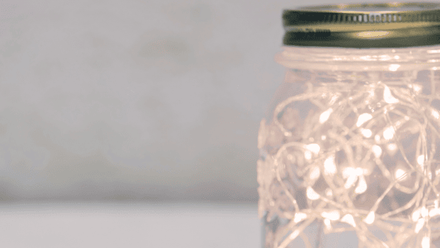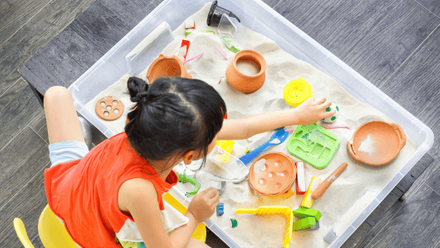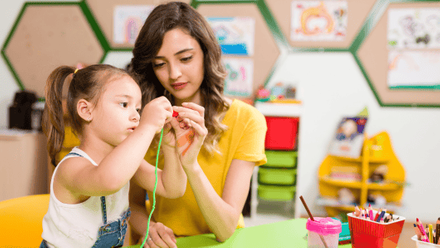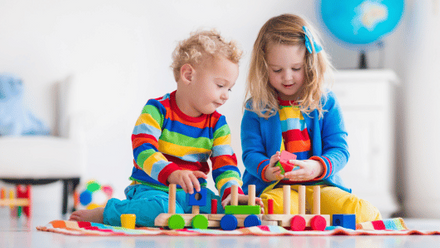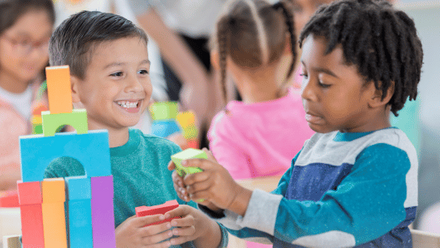The debate: using food as play in early education and care
Messy play. Some professionals love it and are keen to get the room as chaotic as possible with toddlers exploring the messiest materials everywhere. Some professionals would rather have something a little…tidier.
Regardless of our personal stance on getting messy whilst having fun, research tells us that exploring on a multi-sensory level has amazing benefits for different areas of child development, such as:
- physical development, as we explore new ways to use our bodies
- emotional regulation, when we find new sensations that provoke funny feelings
- creativity in our use of materials to create exciting new play opportunities
- coordination as we use different parts of our body at the same time to discover new elements of the messy material.
Sensory play can take many forms but using messy materials is a unique part of extending our sensory processing skills and can be used in a variety of ways with all children.
There is a wide range of materials we can use for messy play and which one(s) we use depends on the context of the setting, the children we work with and the resources around us. Some popular messy play materials include:
-
paint
-
sand
-
mud
-
soap, bubbles and shaving foam
-
water and ice
-
food.
Among these, sensory food play has been a contentious topic within early education and care for many years but, in a time of crisis for increased foodbank use and rising cost of living, the use of food in playtime has sparked debate around how we use food items and the message we are sending to the children and families in our services.
The arguments for
It encourages healthy eating routines
Children’s language of learning is play. Exploring new curiosities and ‘having a go’ are how children learn to navigate the world around them. Play is vital to healthy child development and, despite the famous chastise for doing so, playing with your food is a natural developmental stage for children to take interest in their diets and engage with it in a beneficial way. Playing with food has been suggested to encourage the trying of new textures and tastes to promote a healthy balanced diet.
It is often cheaper and environmentally friendlier than purpose-made resources
With costs rising everywhere around us, early education and care settings are under more pressure than ever to cut costs. In order to sustain high-quality interactions and learning opportunities, when possible, resources need to be maintained and reused to ensure they are cost effective investments. Messy play is rarely reuseable but with its significant qualities to learning through play, should be utilised when possible.
Let's look at an example: children in your setting have been exploring farm animals and the sounds they make. In the small world area, you are keen to get creative with some messy materials to encourage expressive arts through imaginary play. You cut up some grass for the cows and bring in some soil for the pigs. A rough texture to explore with the horses would be great but bark chippings are so expensive. Wheat biscuits are just a fraction of the price and would enable children to build with the blocks or crumble them up. What do we do?
It is accessible
For babies, putting things in our mouths is a superior way for trying out new sensory textures! Oral exploration is simply another way of learning through our senses. Messy play can sometimes involve materials that aren’t suitable for this, making educators wary of using messy play with younger children. Taste-safe messy play is becoming an increasingly popular trend and involves using food creatively through messy play opportunities because it is a safe, accessible option for babies.
The home learning environment is a prime area for developing learning opportunities and professionals working with children in a formal setting should communicate ideas for interactions at home. Food is a household item that can be easily sourced and therefore promotes the value of learning at home in an accessible, often inexpensive, way.
The argument against
It is insensitive to those in poverty
Over 4.3 million children in the UK are growing up in poverty. Living in poverty has wide repercussions on all aspects of living, including access to education, poor physical and mental health and lack of opportunity. The number of households in the UK experiencing food insecurity increased by 2.5 million between 2021 and 2023, resulting in a 94% increase in foodbank use over the past five years. With more families facing hardship, using precious food supplies as an activity in setting can be considered insensitive to families struggling to put food on the table.
It risks allergies and choking
Food allergies are of higher prevalence in young children, with the incidence in toddlers of (often life-threatening) allergy to food estimated at 5-8%. Using food products can become hazardous for children who are undergoing allergy assessments, particularly in cases where staff might not be familiar with individual risks. It can pose an additional risk to children with allergies and create barriers to otherwise fun and engaging learning opportunities.
Similarly, certain food types like raw pasta and rice can pose a choking risk. Children are more likely to associate the food items they play with as something they can eat because they would usually see it on their dinner plates. It can be tricky to communicate the difference with toddlers who are immersed in the play opportunity.
It makes it difficult to implement rules at food times
On the other hand, children who use food during messy play activities may struggle to see the difference in context when they are presented with a bowl of pasta at the lunch table. This means it can be tricky to distinguish with young children when it is okay to ‘play’ with food and when we need to eat it instead. If we spend time during messy play activities telling children not to eat the food but are encouraging eating with the same supplies later on, it can be tricky for children to see the difference and associate the different social context to how they behave.
Round up
Messy play has many unique benefits that provide children with an opportunity to explore open-ended sensory mess with an empowering sense of freedom to get messy and have fun. Whilst messy play can take many forms, using food is popular in settings for its accessibility, affordability and for providing engaging opportunities to teach all about healthy lifestyles. However, during a cost-of-living crisis, using food as a play material can be inconsiderate to families struggling to provide the essentials to their children. It also comes with greater risks of choking and allergies and can make it difficult to establish boundaries during mealtimes.
What do you think? Are you a fan of using food for messy play or not? Let us know by using the forum.

